« IDB Loan for Dam in Ecuador / Préstamo del BID para Represa Hidroeléctrica en Ecuador | Home | A Groundbreaking Carbon Deal for Bolivia / Un Convenio Innovador de Créditos de Carbono para Bolivia »
The Carbon Market 2007, Worldwide and in LAC
By Keith R | May 2, 2007
Topics: Climate Change, Economics & the Environment, Energy & the Environment, Energy Efficiency, Environmental Protection, Renewable Sources | 1 Comment »
At this year’s Carbon Expo, the World Bank’s Carbon Finance Unit released its latest annual report on the state of, and trends in, the global carbon finance market. A PDF of the report in English (so far, copies in other languages are not being offered) can be downloaded at this link. The accompanying press release does a fair job of characterizing the report’s findings, and I’m pressed for time right now, so I am reproducing it below. However, I am also adding to it — first with a couple of the key graphics from the report on the state of the global market (click on each to enlarge), followed by stats regarding the Latin American and Caribbean (LAC) connections to the clean development mechanism (CDM) market, utilizing the latest version of the wonderful data provided by the United Nations Environment Programme’s (UNEP) Risø Centre in its monthly CDM Pipeline spreadsheet report. ¡Buen provecho!
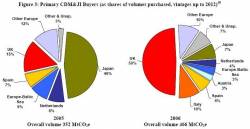 From the World Bank:
From the World Bank:
State of the Carbon Market 2007
Report Documents a Booming Carbon Market
- US$30 billion global market
- US$ 5 billion to developing countries
- US $16 billion leveraged for clean energy in developing countries
The seventh annual World Bank carbon market intelligence study, released today at CARBON EXPO, shows that the global carbon market tripled in 2006—to US$30 billion from US$10 billion in 2005. The market was dominated by the sale and resale of European Union Allowances (EUAs) at a value of nearly US$25 billion. The projects-based market in developing countries and in countries with economies in transition grew sharply to US$5 billion in 2006, more than doubling over the previous year. US$8 billion in new resources for developing countries have been generated through the Kyoto Protocol Mechanisms since 2002, the report states. The market report estimates that direct carbon purchases have leveraged an additional $16 billion in associated investments supporting clean energy in developing countries since 2002.
“These numbers are relevant because they demonstrate that the carbon market has become a valuable catalyst for leveraging substantial financial flows for clean energy in developing countries,” said Warren Evans, World Bank Director of Environment.
Developing world proves pivotal to greenhouse gas reductions
According to the State and Trends of the Carbon Market 2007, the developing world has contracted one billion tons of greenhouse gas emission reductions and is on track to bring an additional billion tons to the market by 2012.
“These figures show the important contribution of the developing world to climate change mitigation. The additional billion tons from developing countries amounts to half of what Japan and the European Union together need to reduce, from now until the end of the Kyoto Protocol commitment period,” said Karan Capoor, World Bank financial specialist and co-author of the market report.
Added Philippe Ambrosi, also of the World Bank and co-author of the report, “These numbers for the regulated carbon market should give comfort to other countries considering new climate change policies, that high quality emission reductions from developing countries can help them abate carbon emissions in a financially more efficient way.”
Private efforts to reduce climate change
The voluntary market—for actions by individuals and companies not required by the Kyoto Protocol or other regimes—is also taking off with more than 50 companies offering offsets. Some estimates presented in the state of the carbon market report, put the volume of the voluntary market by 2010 at 400 million tons a year, equaling the size of the CDM. But those predictions come with a strong caveat. The report warns that ‘this high-potential voluntary segment, however, lacks a generally acceptable standard, which remains a significant reputation risk not only to its own prospects, but also to the rest of the market, including the segments of regulated emissions trading and project offsets.’ There are efforts underway in the market to create acceptable, voluntary standards for offset projects.
The State and Trends of the Carbon Market 2007 reviewed the trends of the carbon market based on material provided by carbon market analysts and on interviews with a large number of market participants. The report is based on data from the trading of EUAs under the European Union’s
Emissions Trading Scheme (EU ETS) and from transactions completed under the Kyoto Protocol’s flexible mechanisms—Clean Development Mechanism (CDM) and Joint Implementation (JI)—that allow industrialized countries to purchase greenhouse gas emission reductions in developing countries and in countries with economies in transition and also includes data from voluntary markets. Natsource LLC, which provides advisory and research services in emissions and renewable energy markets contributed to the report.
“The greenhouse gas markets continued to grow and mature in 2006,” said Jack Cogen, President of Natsource LLC. “In 2006, we saw growing activity in this asset class not only from industrial companies that must meet compliance targets but also newer participants, like commercial firms, banks and financial institutions that recognize the attractiveness of this market for managing risks and earning returns on capital. Natsource will continue to use its expertise to help our customers reduce their costs to comply with greenhouse gas targets and to take advantage of opportunities in these growing markets.”
The market analysis shows that transactions from projects in developing countries and economies in transition totaled 466 million tons of greenhouse gas emission reductions and in the EU ETS, some 1.1 billion tons of allowances were transacted. But as much as the market has grown, the report pointed out that ‘the enormity of the climate challenge however will require a profound transformation, including in those sectors that cap-and-trade markets cannot easily reach. These include making public and private investments in research and development for new technology development and diffusion, economic and fiscal policy changes, programmatic approaches to decouple economic growth from emissions development as well as the removal of distortionary subsidies for high-carbon fuels and technologies.’
The report was released to more than 2000 participants including greenhouse gas emission reductions buyers and sellers, intermediaries and service providers from companies and countries around the world, participating in CARBON EXPO 2007.
The Most Recent Data for LAC (click on each to enlarge)
Tags: América Latina, Banco Mundial, carbon finance, carbon market, clean development mechanism, ETS, financiamiento de carbono, gases de efecto invernadero, greenhouse gases, Latin America, mecanismo de desarrollo limpio, mecanismo de desenvolvimento limpo, PNUMA, Risø Centre, UNEP, World Bank



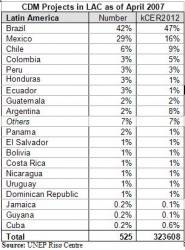
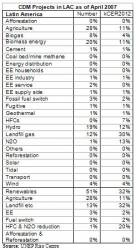
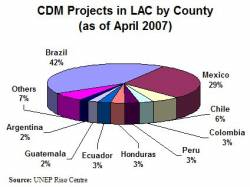
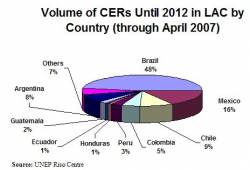
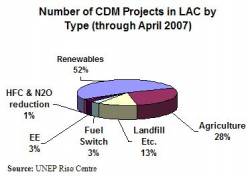
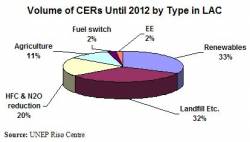
May 8th, 2007 at 5:14
Wow great read – very informative